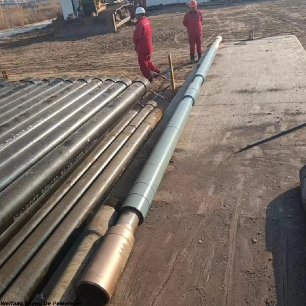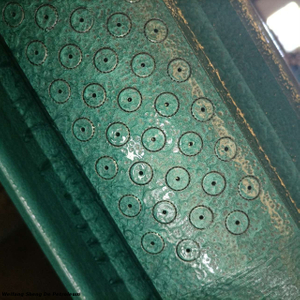A hydraulic jar is a vital downhole tool designed to deliver a sudden impact to free stuck drilling equipment during oil and gas well operations. It uses controlled hydraulic pressure to store energy and release it in a sharp jolt, helping to dislodge obstructions without damaging surrounding tools or the wellbore. In drilling, equipment can become stuck due to differential sticking, key seating, or hole collapse. The hydraulic jar serves as a safety and efficiency tool, allowing crews to overcome such problems quickly. Its precision and durability have made it an essential component in modern drilling assemblies, significantly reducing downtime and operational risks.
Introduction to Hydraulic Jars
A hydraulic jar is a specialized device used primarily in oil and gas drilling to deliver a powerful jarring action downhole. The main purpose of this tool is to help release stuck drill strings, fishing tools, or other downhole equipment that might become lodged in the borehole. Unlike mechanical jars, hydraulic jars rely on the movement of hydraulic fluid to create a delayed release of energy, which translates into a sudden, forceful impact in a chosen direction.
In the drilling industry, time is money. Any stuck equipment can halt operations and lead to costly delays. By integrating a hydraulic jar into the drill string, operators have a built-in solution to free obstructions without pulling the entire string out of the hole, which can take hours or even days.
Basic Structure of a Hydraulic Jar
The hydraulic jar consists of several main components, each designed to withstand the extreme conditions of the downhole environment.
Outer Barrel – The robust cylindrical housing that protects the internal components from external pressure, debris, and wear.
Mandrel or Inner Rod – The central moving part that transmits axial force and is responsible for delivering the impact.
Hydraulic Chamber – The sealed section containing hydraulic oil that controls the delay and release mechanism.
Seals and Bearings – High-strength seals keep the hydraulic fluid contained while bearings allow smooth movement.
Impact Surfaces – Hardened steel contact points where the stored energy is released as a shock.
The materials used for hydraulic jars are typically high-grade alloy steels with heat-treated surfaces to resist wear, corrosion, and fatigue. Since these tools operate in deep wells with high temperatures, the materials must handle both extreme heat and mechanical stress.
Primary Functions
The hydraulic jar plays several important roles in oilfield operations:
Releasing Stuck Tools – Whether the problem is caused by differential sticking, collapsed formation, or debris in the borehole, the hydraulic jar can deliver the necessary force to dislodge the stuck section.
Delivering Upward or Downward Impact – Depending on the type of jar and the situation, it can provide an impact in either direction to help free equipment.
Protecting Other Downhole Tools – By delivering a controlled jolt rather than continuous force, the jar reduces the risk of damaging sensitive downhole instruments.
The key advantage here is that hydraulic jars provide high-impact energy without the operator having to apply excessive continuous pulling or pushing force, which could damage both the drill string and the formation.
Types of Hydraulic Jars
Hydraulic jars come in several configurations, each suited for specific operations:
Upward-Acting Hydraulic Jar
Designed to deliver an impact in the upward direction. This is typically used when pulling the drill string or fishing tools free from obstructions.
Downward-Acting Hydraulic Jar
Releases a strong downward blow, useful when tools are stuck and need to be driven or jarred downward to dislodge.
Bi-Directional Hydraulic Jar
Capable of delivering both upward and downward impacts, offering maximum flexibility in complex drilling or fishing operations.
Choosing the right jar type depends on the well conditions, the nature of the obstruction, and the operational goals.
Advantages Over Mechanical Jars
Hydraulic jars offer several benefits that make them preferable to mechanical jars in many drilling operations:
More Precise Impact Control
The hydraulic delay mechanism allows the operator to control the timing and magnitude of the impact more accurately, which is crucial in sensitive operations.
Smoother Operation
The fluid-based delay reduces sudden mechanical stress, allowing for smoother engagement and release compared to purely mechanical designs.
Lower Maintenance Requirements
Because hydraulic jars have fewer moving mechanical trigger parts, they typically experience less wear and require less frequent servicing.
Consistent Performance in Deep Wells
Hydraulic systems are less affected by the high tension and compression forces in extended drill strings, ensuring reliable activation even at great depths.
These advantages translate into higher operational efficiency, reduced downtime, and improved tool life.
Typical Applications in Oilfield Operations
Hydraulic jars are used in various scenarios during drilling and well intervention work:
Freeing Stuck Tools During Drilling
When the drill bit or bottom hole assembly becomes lodged due to rock sloughing, key seating, or mud differential sticking, the jar can be activated to release the obstruction quickly.
Downhole Testing
In some well testing operations, jars are used to initiate certain mechanical actions or to free test tools that have become stuck.
Fishing Operations
When retrieving broken or lost equipment from the wellbore, hydraulic jars provide the force needed to dislodge and recover the fish.
Maintenance of Downhole Equipment
They can help in removing lodged casing, tubing, or packers during maintenance operations.
Because of their versatility, hydraulic jars are considered a must-have in most drilling and fishing toolkits.
How a Hydraulic Jar Works in Practice
When operating a hydraulic jar, the driller applies either tensile (pulling) or compressive (pushing) force to the drill string. This force compresses the hydraulic chamber, and the fluid flow is restricted by a calibrated metering system, creating a delay. Once the internal resistance is overcome, the mandrel moves rapidly, releasing stored energy as an impact.
The delay mechanism is essential because it allows the operator to build up sufficient energy without prematurely triggering the impact. The controlled release also ensures that the shock is delivered exactly where and when it is needed.
Maintenance Considerations
While hydraulic jars are robust, regular maintenance is necessary to keep them performing at peak efficiency. This includes:
Checking seals for wear or leakage.
Ensuring hydraulic oil is clean and free of debris.
Inspecting mandrels and barrels for scoring or corrosion.
Testing delay times to ensure consistent performance.
A well-maintained hydraulic jar can last for many years, even under the harshest drilling conditions.
Safety Precautions
Using hydraulic jars involves handling significant stored energy. Operators should:
Always follow manufacturer guidelines for activation forces and delays.
Ensure the jar is compatible with the rest of the bottom hole assembly.
Avoid excessive or uncontrolled impacts, which could damage equipment.
Maintain clear communication between rig floor personnel during jarring operations.
Safety is critical because an improperly activated jar can cause tool damage or even pose a hazard to the crew.
Conclusion
The hydraulic jar is a vital tool in oil and gas drilling, delivering precise, controlled impacts to free stuck equipment without the delays and high costs of full retrieval operations. Its advanced hydraulic delay mechanism ensures smooth jarring action that protects both the wellbore and downhole tools, making it ideal for routine drilling, fishing, and well intervention tasks. Whether in upward, downward, or bi-directional configurations, hydraulic jars provide the durability, precision, and adaptability needed for demanding field conditions.
For high-quality hydraulic jars you can trust, Weifang Shengde Petroleum Machinery Manufacturing Co., Ltd. offers proven solutions backed by years of expertise in petroleum equipment manufacturing. Their products are engineered for reliability, efficiency, and safety in even the toughest drilling environments. To learn more or discuss your specific operational needs, we recommend visiting their website or contacting their technical team for professional support.
















